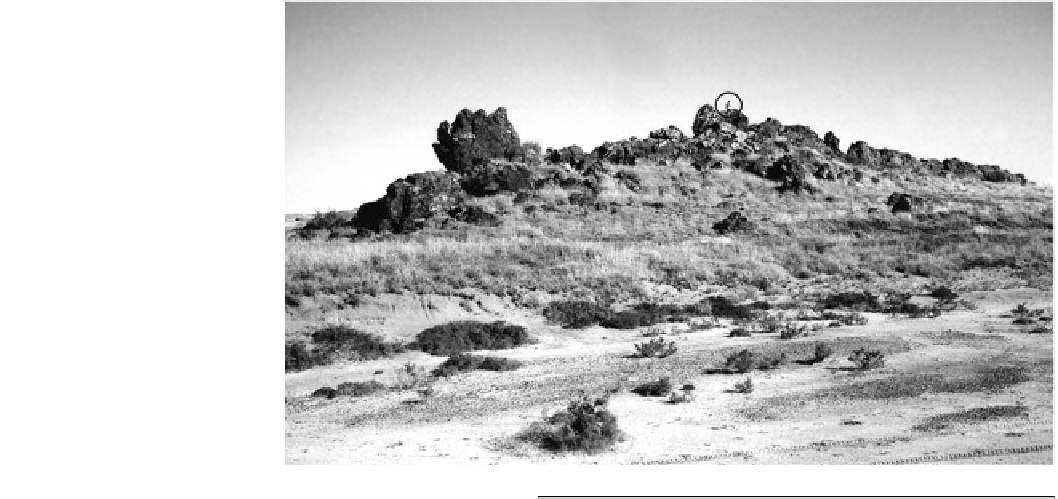Geoscience Reference
In-Depth Information
Fig. 4.15
Streamlined inverted
keel-shaped ridge with a
cockscomb-like protuberance at
Point Samson, northwest Western
Australia. Note the resemblance
of the cockscomb to that shown
from left-to-right. Intense vorti-
ces embedded in helical flow
plucked blocks of bedrock from
the sides of the ridge. The ridge is
aligned with other bedrock fea-
tures in the region. Scale is the
person circled at the top
Storms are significant events in the coastal environment.
Nonetheless, tsunami are an alternative mechanism for
reworking coastal sediment and ultimately for imprinting
upon the landscape a signature of convulsive events that in
some areas has not been removed over thousands of years.
The difficulty in invoking storms for all coastal deposition
and erosion lies not just in the insufficient magnitude of
observed events but also in the inapplicability of storm
wave processes to account for a suite of anomalous
deposits. For instance, dump deposits, bouldery mounds,
and chevron ridges contain chaotic mixtures of sediment
that cannot be explained by storm waves because such
waves erode sand from the shoreline, transport coarse sed-
iment shoreward as a body, and sort debris in a shore nor-
mal direction. Storms also cannot account for bedrock
sculpturing. Tsunami can move and deposit highly bimodal
sediment mixtures and create the suites of high-magnitude
depositional and erosional signatures that dominate many
landscapes worldwide. This evidence cannot be ignored.
The only question that remains is, ''What causes these
tsunami''? To answer this question one must examine the
type of deposits and landscapes produced by earthquakes,
volcanoes, and submarine landslides that are the main
causative mechanisms of tsunami. In addition, comet/
asteroid impacts with the ocean cannot be ignored. As will
be shown, the flux of comets and asteroids has been sub-
stantially greater over the past two millennia than at present.
This increased frequency has been observed and reported
in legends, but never in documents that can be inter-
preted from a modern perspective, or that can withstand
the scrutiny of contemporary scientific methodology.
Authentication of comet/asteroid-generated tsunami as an
underrated
References
C. Andrade, Tsunami generated forms in the Algarve barrier islands
(South Portugal). Sci. Tsunami Hazards 10, 21-33 (1992)
V.R. Baker, in Paleohydraulics and Hydrodynamics of Scabland
Floods, ed. by V.R. Baker, D. Nummedal. The Channeled
Scabland. NASA Office of Space Science, Planetary Geology
Program, Washington, pp. 59-79 (1978)
V.R. Baker (ed.), Catastrophic Flooding: The Origin of the Channeled
Scabland. (Dowden Hutchinson & Ross, Stroudsburg, 1981), p. 360
W.L. Bascom, Ocean waves. Sci. Am. 201, 74-84 (1959)
J. Bourgeois, E.L. Leithold, in Wave-Worked Conglomerates—Depo-
sitional Processes and Criteria for Recognition, ed. by E.H.
Koster, R.J. Steel. Sedimentology of Gravels and Conglomerates.
Canadian Society of Petroleum Geologists Memoir, vol 10 (1984),
pp. 331-343
F.G. Bourrouilh-Le Jan, J. Talandier, Sédimentation et fracturation de
haute énergie en milieu récifal: tsunamis, ouragans et cyclones et
leurs effets sur la sédimentologie et la géomorphologie d'un atoll:
Motu et hoa, à Rangiroa, Tuamotu, pacifique SE. Mar. Geol. 67,
263-333 (1985)
E.A. Bryant, The effect of storms on Stanwell Park, NSW beach
position, 1943-1980. Mar. Geol. 79, 171-187 (1988)
E. Bryant, Natural Hazards, 2nd edn. (Cambridge University Press,
Cambridge, UK, 2005)
E.A. Bryant, S.B. McCann, Long and short term changes in the barrier
islands of Kouchibouguac Bay, southern Gulf of St. Lawrence.
Can. J. Earth Sci. 10, 1582-1590 (1973)
E. Bryant, J. Nott, Geological indicators of large tsunami in Australia.
Nat. Hazards 24, 231-249 (2001)
E. Bryant, R.W. Young, Bedrock-sculpturing by tsunami, South Coast
New South Wales, Australia. J. Geol. 104, 565-582 (1996)
E. Bryant, R.W. Young, D.M. Price, Evidence of tsunami sedimen-
tation on the southeastern coast of Australia. J. Geol. 100, 753-765
(1992)
E. Bryant, R.W. Young, D.M. Price, Tsunami as a major control on
coastal
evolution,
Southeastern
Australia.
J.
Coastal
Res.
12,
831-840 (1996)
E. Bryant, R.W. Young, D.M. Price, D. Wheeler, M.I. Pease, The
impact of tsunami on the coastline of Jervis Bay, southeastern
Australia. Phys. Geogr. 18, 441-460 (1997)
and
significant
hazard
will
be
presented
in

